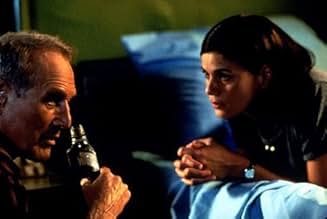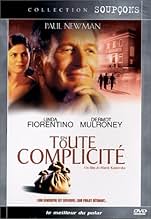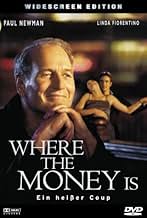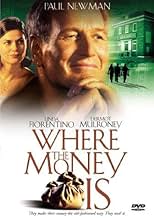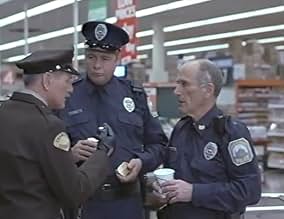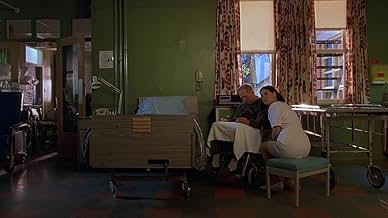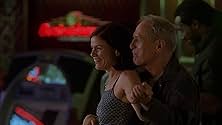AVALIAÇÃO DA IMDb
6,3/10
6,7 mil
SUA AVALIAÇÃO
O velho ladrão de bancos Henry, paralisado por um derrame, é transferido de um hospital da prisão para uma casa de repouso, onde Carol trabalha como enfermeira.O velho ladrão de bancos Henry, paralisado por um derrame, é transferido de um hospital da prisão para uma casa de repouso, onde Carol trabalha como enfermeira.O velho ladrão de bancos Henry, paralisado por um derrame, é transferido de um hospital da prisão para uma casa de repouso, onde Carol trabalha como enfermeira.
- Direção
- Roteiristas
- Artistas
Irma St. Paule
- Mrs. Galer
- (as Irma St. Paul)
Rita Tuckett
- Mrs. Weiler
- (as Rita Tucket)
Rod McLachlan
- Lloyd the Cop
- (as Roderick McLachlan)
Avaliações em destaque
At the time of it's short theatrical release, "Where the Money Is" just didn't seem like a very appealing film. And due to it hitting video store shelves within only a matter of months, I had decided that this film just wouldn't be that great. But, I decided to check it out anyway and I am very happy I did. What we are given with "Where the Money Is" is a classy caper flick with some good performances. Although not a classic, WTMI is definately good wholesome entertainment. The script focuses more on intrigue and comedy, rather than the profanity and violence that most caper flicks are centered around. This one is a rare gem, and I'm glad I found it. 8.5/10
Age has pared Paul Newman's fine features to a sketch - it's also honed his huge movie appeal to such basics that he can pretty much maintain our attention while in a coma. But as if to test his powers, in the shagging and intriguing caper "Where the money is", Newman plays Henry, a former famous bank robber and current guest of the prison system who actually is in a coma, or at least a stroke like state of suspended animation. Slumped and glazed, Henry sits for hours in his wheelchair at the nursing home to which he has been transferred tended to by Carol (Linda Fiorentino) a less than angelic nurse and onetime prom queen. Carol lives with her husband, in the same drab town where she grew up. She's bored as a former prom queen always is. And she's convinced that Henry - who had led the only interesting life around - is faking his stupor. So she bamboozles him into dropping his act, then promises to keep the secret, if he'll include her on just one more Bonnie and Clyde size heist. British director Marek Kanievska counts on the audience knowing that Newman's fame is tied to playing heist pros and hustlers, and that we're not just seeing some gravel voiced coot in a wheelchair - we're seeing what Butch Cassidy might have become had he not messed up in Bolivia. The minimalist acting the star has done in recent films like "Message in a bottle" and "Nobody's fool" serves him well, because he's confident - rightfully so- that the audience will fill in the blanks. Incorrigible Henry is fundamentally opaque, but canny Newman lets his eyes do the talking. As for Fiorentino, the star of "The last seduction" reprises her dangerous, restless woman persona as if to remind us (and casting agents) that if she got every role currently going to Catherine Zeta Jones, movies would be a lot more interesting. The payoff is the clash between a taciturn bandit faking feebleness and an angry Florence Nightingale, faking compassion, played by two actors who are the real thing.
For admirers of quality movies, one of the greatest sources of frustration has always been the inverse ration that exists between movies that are good and movies that make money. The essential rule of thumb is that, with few exceptions, the larger a film's budget happens to be, the less likely that that film will have anything new or original to say. The corollary principle is that, given the choice between patronizing a film that is original, complex and meaningful and one that is derivative, simpleminded and thematically empty, the mass audience will go with the latter type every time. Driven by the need for profits, large studios are then forced to cater to this `lowest common denominator' mentality. The result is that wonderful little films are almost invariably squeezed out of the marketplace, left to languish in obscure art houses scattered in a few major cities, while bloated, mindless multi-million dollar monstrosities fill sprawling megaplexes found in cities, suburbs and rural areas stretching literally from coast to coast.
How many people, for instance, have even heard of, let alone seen, `Where the Money Is'? Yet here is a film dedicated to the spirit of pure fun, a lighthearted black comedy that is blessedly free of the hardboiled cynicism and explicit violence that plague so many such films. The film hooks the audience from the very start with the originality of its plot and setting. Set in a small Oregon town (though the film was, rather inexplicably, filmed in the environs of Montreal), the movie stars the superb Linda Fiorentino and Dermot Mulroney as long time high school sweethearts who have married right after graduation, found their comfortable little niche in the small world they inhabit and now begun to take each other for granted. (The opening scene introduces us to them as they are roadhousing around on prom night in his prize Mustang, the one symbol of a rebellious youth that he still clings to all these years later). It is at her job as a nurse at a local convalescent hospital that a measure of excitement reenters their humdrum lives and relights the long dormant spark of adventure that she, in particular, has been missing. This novelty comes in the form of an aging bank robber (Paul Newman) who has apparently suffered a stroke and is sent to the rest home due to overcrowding at the prison hospital.
The early scenes of the film are wickedly funny as Fiorentino, suspicious that her new patient may just be faking it, plays a clever little game of cat-and-mouse to try to catch him in his impressive charade. Suddenly, having achieved her goal, she is not quite so sure who is really the cat and who the mouse.
To say more about the plot would really do a disservice to this film, which manages to keep us intrigued by the unpredictability of its most unusual setup. Fiorentino and Mulroney are thoroughly believable as a couple of once-edgy youngsters grown into responsible, comfortable but slightly restless adults. She, in particular, finds herself stifled by the humdrum quality of both their life and their marriage together. Mulroney, on the other hand, seems to have pretty much lost that desire for living on the edge, yet, for her sake and, perhaps, for the sake of that tiny spark for adventure that still lives unquenched somewhere deep inside him, he is willing to meet her halfway even if a bit reluctantly on the field of lawlessness. Newman, as the expert bank robber who stumbles unexpectedly into their lives, provides the perfect catalyst for renewed adventure.
The amazing thing about `Where the Money Is' is that, thanks to its writers, Max Frye, Topper Lilien and Carroll Cartwright, and the director, Marek Kanievska, the film never ends up taking itself too seriously. It always knows that its prime purpose is to give the audience a fun time. This it does with the help of its three dazzling stars, who seem to be having the time of their professional lives (Fiorentino is especially wonderful). It sure must be infectious, because we, in the audience, have a pretty damn good time watching them.
How many people, for instance, have even heard of, let alone seen, `Where the Money Is'? Yet here is a film dedicated to the spirit of pure fun, a lighthearted black comedy that is blessedly free of the hardboiled cynicism and explicit violence that plague so many such films. The film hooks the audience from the very start with the originality of its plot and setting. Set in a small Oregon town (though the film was, rather inexplicably, filmed in the environs of Montreal), the movie stars the superb Linda Fiorentino and Dermot Mulroney as long time high school sweethearts who have married right after graduation, found their comfortable little niche in the small world they inhabit and now begun to take each other for granted. (The opening scene introduces us to them as they are roadhousing around on prom night in his prize Mustang, the one symbol of a rebellious youth that he still clings to all these years later). It is at her job as a nurse at a local convalescent hospital that a measure of excitement reenters their humdrum lives and relights the long dormant spark of adventure that she, in particular, has been missing. This novelty comes in the form of an aging bank robber (Paul Newman) who has apparently suffered a stroke and is sent to the rest home due to overcrowding at the prison hospital.
The early scenes of the film are wickedly funny as Fiorentino, suspicious that her new patient may just be faking it, plays a clever little game of cat-and-mouse to try to catch him in his impressive charade. Suddenly, having achieved her goal, she is not quite so sure who is really the cat and who the mouse.
To say more about the plot would really do a disservice to this film, which manages to keep us intrigued by the unpredictability of its most unusual setup. Fiorentino and Mulroney are thoroughly believable as a couple of once-edgy youngsters grown into responsible, comfortable but slightly restless adults. She, in particular, finds herself stifled by the humdrum quality of both their life and their marriage together. Mulroney, on the other hand, seems to have pretty much lost that desire for living on the edge, yet, for her sake and, perhaps, for the sake of that tiny spark for adventure that still lives unquenched somewhere deep inside him, he is willing to meet her halfway even if a bit reluctantly on the field of lawlessness. Newman, as the expert bank robber who stumbles unexpectedly into their lives, provides the perfect catalyst for renewed adventure.
The amazing thing about `Where the Money Is' is that, thanks to its writers, Max Frye, Topper Lilien and Carroll Cartwright, and the director, Marek Kanievska, the film never ends up taking itself too seriously. It always knows that its prime purpose is to give the audience a fun time. This it does with the help of its three dazzling stars, who seem to be having the time of their professional lives (Fiorentino is especially wonderful). It sure must be infectious, because we, in the audience, have a pretty damn good time watching them.
This movie, like most caper films, builds slowly to a pretty satisfying conclusion. The three main stars are likable, and of course Paul Newman is a jewel as always. Linda is not as seductive as in some of her roles, but is,as always, a pleasure to watch. Some younger folks might find this too slow, but more mature audiences will probably enjoy it
Two days ago, one of the greatest actors of all time left this life. Paul Leonard Newman was best known for films like "Hud", "Butch Cassidy and the Sundance Kid" and "The Verdict". But he also starred in small, less noticed movies over the years. One example is "Where the Money Is". Newman plays an aged crook who moves into a nursing home where it becomes clear to the woman (Linda Fiorentino) running the place that he's not as disabled as he claims to be and might in fact be looking for help in pulling off another heist.
OK, so an elderly criminal going in for one last scheme is sort of a hackneyed plot. But in this role, Newman doesn't even need to talk much; it seemed to me as if his eyes functioned as actors. Not to mention that there's some great chemistry between him and Fiorentino. This might not be the most noticeable movie, but it's worth seeing, if only once. There will never be another Paul Newman.
Also starring Dermot Mulroney.
OK, so an elderly criminal going in for one last scheme is sort of a hackneyed plot. But in this role, Newman doesn't even need to talk much; it seemed to me as if his eyes functioned as actors. Not to mention that there's some great chemistry between him and Fiorentino. This might not be the most noticeable movie, but it's worth seeing, if only once. There will never be another Paul Newman.
Also starring Dermot Mulroney.
Você sabia?
- CuriosidadesPaul Newman's final starring role in a film. His remaining film work would be in supporting roles and voice-overs.
- Erros de gravaçãoWhile the talk is about toaster ovens, the bank offers toasters only - the billboards clearly show a toaster and the description is 'toaster', not 'toaster oven'.
- Citações
Henry Manning: Honey, I'm playing brain dead, not brain damaged.
- Trilhas sonorasYou Might Think
Performed by The Cars
Written by Ric Ocasek
Courtesy of Elektra Entertainment Group
By Arrangement with Warner Special Products
Principais escolhas
Faça login para avaliar e ver a lista de recomendações personalizadas
- How long is Where the Money Is?Fornecido pela Alexa
Detalhes
- Data de lançamento
- Países de origem
- Centrais de atendimento oficiais
- Idioma
- Também conhecido como
- O Grande Golpe
- Locações de filme
- Empresas de produção
- Consulte mais créditos da empresa na IMDbPro
Bilheteria
- Orçamento
- US$ 28.000.000 (estimativa)
- Faturamento bruto nos EUA e Canadá
- US$ 5.661.798
- Fim de semana de estreia nos EUA e Canadá
- US$ 2.513.530
- 16 de abr. de 2000
- Faturamento bruto mundial
- US$ 7.450.414
- Tempo de duração
- 1 h 29 min(89 min)
- Cor
- Mixagem de som
- Proporção
- 1.85 : 1
Contribua para esta página
Sugerir uma alteração ou adicionar conteúdo ausente


